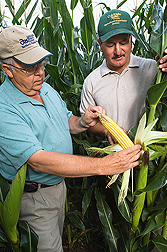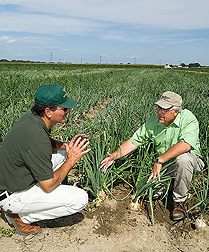Lowering Nitrogen Rates To Increase
Profit, Environmental Sustainability
More fertilizer doesn’t always mean more profit. That’s one conclusion from a 10-year study conducted by Agricultural Research Service and Colorado State University (CSU) scientists. Soil scientist Ardell Halvorson, at the ARS Soil Plant Nutrient Research Unit, in Fort Collins, Colorado, led the investigation, which focused on nitrogen fertilizer management for various rotations of irrigated crops.
The research examined cropping practices in the Arkansas River Valley, an agricultural region of Colorado where vegetables and melons are grown in rotation with wheat, corn, alfalfa, and soybeans. The area has high levels of nitrate-nitrogen in the fields and groundwater—due, in part, to heavy application of nitrogen fertilizer and prevalence of shallow-rooted crops such as onions.
From 1998 to 2008, the Fort Collins researchers evaluated and compared potential management strategies for reducing nitrogen and nitrate-nitrogen levels in soil and, consequently, groundwater. Their research-based recommendations could have important economic and environmental benefits for the region.
Onions, Alfalfa, and Melons—Oh My!
The first study, conducted in 1998, examined nitrogen-use efficiency in onions and showed that the crop used only about 12-15 percent of the nitrogen fertilizer applied to it. Much of the remainder stayed in the soil.
“In our fields, the top 6 feet of soil had accumulated—over several years—about 700 pounds of nitrogen per acre,” Halvorson says. “These numbers were typical of what had been reported by farmers in the valley.”
The next year, he and his colleagues planted corn on the same land and found that it recovered about 24 percent of the nitrogen fertilizer applied to the onion crop. It’s unusual to consider corn as a nitrogen scavenger, because it is generally thought to require a lot of fertilizer. But the unfertilized corn grown on that land yielded about 239 bushels per acre.
“That’s a very respectable corn yield, particularly for an unfertilized field,” Halvorson says.
Following that study, the scientists grew alfalfa on the land for 5 years and followed it with a watermelon crop. Alfalfa is a legume, meaning it can actually increase the amount of nitrogen available in the soil through a process called “nitrogen fixation.” The researchers applied a light amount of nitrogen with the phosphorus fertilizer to the alfalfa crop and left the watermelon unfertilized. After that, they planted corn on the soil.
|
|
“There was so much residual nitrogen in the soil profile that we got no corn-yield response the first year to the nitrogen fertilization,” Halvorson says. The amount of available nitrogen in the soil was so high, in fact, that four consecutive corn crops were raised on the land before the level dropped below 100 pounds per acre in the top 6 feet.
The first year, the unfertilized control plot yielded about 250 bushels of corn. The heavily fertilized plot, which received 250 pounds of nitrogen per acre, yielded about 260 bushels—a small increase that required a significantly higher investment of time and money.
Many farmers in the area base their nitrogen applications on recommendations from local universities. These guidelines suggest that raising 240 bushels of corn on this field would require between 100 to 235 pounds of nitrogen per acre. If no onions or other vegetables had been grown on the land previously, that amount probably would have been necessary, Halvorson says. But growing vegetables requires fertilizer, increasing the amount of mineral nitrogen in the soil profile. With higher nitrogen levels in the soil, farmers could benefit from lower nitrogen fertilization rates for corn.
For Onions, It’s Hip To Drip
After the 2003 corn harvest, the researchers grew chili peppers in 2004 and then onions. The peppers were fertilized with 0 to 150 pounds of nitrogen per acre, and the onions received 0 to 200 pounds per acre. They found that onions grown under drip irrigation required less nitrogen and water than those grown under furrow irrigation. Yields were higher, and soil erosion was lower with drip. Under either system of irrigation, onions required less nitrogen than farmers in the area typically apply.
“Using either drip or furrow irrigation, you could optimize your yield potential and economic returns with about 120 pounds of nitrogen per acre—well under the typical 200 pounds,” Halvorson says.
The onion crop left a lot of nitrogen in the soil. After the study, the scientists grew corn for 2 years before soil nitrogen levels dropped to where they’d been before the onions were planted.
In 2006, the scientists grew onions on land that had last been occupied by soybeans—another nitrogen-fixing legume. Again, typical fertilizer rates had no significant benefits for onions planted after a nitrogen-fixing crop. And drip irrigation again proved more profitable than furrow.
Halvorson and his colleagues concluded that drip irrigation of onion crops offers greater economic and environmental benefits and that reducing fertilization in the Arkansas River Valley could actually increase profits.
Spreading the Word
This research has applications for vegetable-producing areas throughout Colorado, but the economic and environmental benefits of adopting these practices are particularly significant in regions like the Arkansas River Valley, where water resources are limited.
Mike Bartolo, manager of CSU’s Arkansas Valley Research Center, has been involved in this study from the beginning.
“For many years, overapplication of nitrogen wasn’t that much of an issue for vegetable growers because it was a small fraction of their overall production budget,” Bartolo says.
That’s changed in recent years as fertilizer and other production costs have risen across the nation. The farmers Bartolo interacted with became increasingly aware of the soil nitrogen composition of their fields and of the economic and environmental impacts of overfertilizing with nitrogen. As production costs increased, so did the number of inquiries he received about using nitrogen efficiently.
When the questions started coming in, Bartolo and Halvorson referred the farmers to the results of their studies and argued for reduced nitrogen application.
“Because we’d been working on the study for so long, we already had information available when the local farmers started asking us how to improve their efficiency,” Bartolo says. “The information was there, and it was put to use right away.”—By Laura McGinnis, Agricultural Research Service Information Staff.
This research is part of Water Resource Management (#201), Soil Resource Management (#202), and Global Change (#204), three ARS national programs described on the World Wide Web at www.nps.ars.usda.gov.
Ardell D. Halvorson is in the USDA-ARS Soil Plant Nutrient Research Unit, Natural Resources Research Center, 2150 Centre Ave., Building D, Fort Collins, CO 80526-8119; phone (970) 492-7230, fax (970) 492-7213.
"Lowering Nitrogen Rates To Increase Profit, Environmental Sustainability" was published in the February 2009 issue of Agricultural Research magazine.









